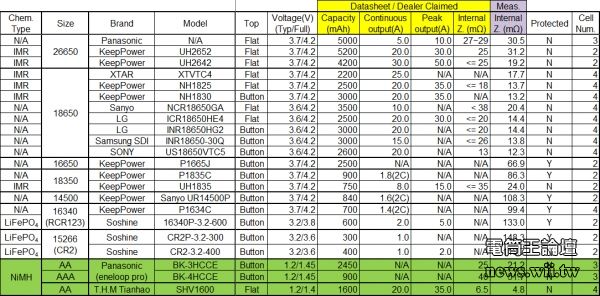Uxorious
Newly Enlightened
Hi All,
I already share the following data in a Taiwanese forum, so there is watermark on the pictures~
http://www.wii.tw/~fogerdis/viewthread.php?tid=48943&page=1#pid253384
Not using a very professional equipment, the impedance meter is named "ZY05L" :
http://www.aliexpress.com/item/ZY05...ltmeter-nickel-metal-hydride/32371737562.html
It uses Kevin clip 4-wires AC sensing, so I think the results still comparable between all the batteries.
Last thing is I use the GW Instek GTL-108A test lead.


Sorry for my bad English .......
Any comments and suggestions are welcome !!
Update:
I'll try to find the datasheet or dealer's description of all the batteries:
As you can see, although it's not really useful for the "DC" application,
the internal impedance value measured by my setup is close to the datasheet or dealer's description.
10/3 Update:
Got 4 AA NiMH speical design for Mini 4WD racing,although the capacity is small (1600mAh),
but the 1kHz impedance is really quite low (only 4.8mΩ) !! Even lower than Li-ion batteries.
30A discahrge curve by the supplier in post #84:
http://tcfans.org/bbs/dispbbs.asp?page=9&id=2250&boardid=9
26650:
Panasonic - 26650 5000mAh - 27~29mΩ
https://item.taobao.com/item.htm?spm=a1z09.2.0.0.g2tg4C&id=37736658887&_u=fjtd1e8768d
KeepPower - IMR26650 5200mAh - 25mΩ
https://item.taobao.com/item.htm?spm=a1z09.2.0.0.g2tg4C&id=42076860730&_u=fjtd1e8365f
KeepPower - IMR26650 4200mAh - Max. 25mΩ
https://item.taobao.com/item.htm?spm=a1z09.2.0.0.g2tg4C&id=41520919785&_u=fjtd1e862c8
18650:
XTAR - XTVTC4 - N/A
http://www.xtarlight.com/05-chanpin/p-001-1.asp?styleid=335
KeepPower - IMR18650 2500mAh - Max. 18mΩ
https://item.taobao.com/item.htm?spm=a1z09.2.0.0.g2tg4C&id=41358133103&_u=fjtd1e8e05b
KeepPower - IMR18650 3000mAh - N/A
http://www.keeppower.com.cn/products_detail.php?id=509
Sanyo - NCR18650GA - <38mΩ @AC 1KHz
http://www.hurt.com.pl/prods/bat/_li_ion/ncr18650ga.pdf
LG - ICR18650HE4 - <=20mΩ @AC 1KHz
https://cdn.shopify.com/s/files/1/0674/3651/files/LG18650_HE4.PDF?828
LG - INR18650HG2 - <=20mΩ @AC 1KHz
http://keeppower.com.ua/download/2015-06/datasheet-LG_INR18650HG2-1.pdf
Samsung SDI - INR18650 30Q - <=26mΩ
http://www.hurt.com.pl/prods/bat/_li_ion/18650-30q.pdf
SONY - US18650VTC5 - 13mΩ(Typ.) @AC 1KHz
https://cdn.shopify.com/s/files/1/0674/3651/files/VTC5.pdf?740
Others:
KeepPower - 16650 - N/A
http://www.keeppower.com.cn/products_detail.php?id=335
KeepPower - 18350 - N/A
http://www.keeppower.com.cn/products_detail.php?id=359
KeepPower - IMR18350 - Max. 35mΩ
https://item.taobao.com/item.htm?spm=a1z09.2.0.0.6m49mQ&id=41131664831&_u=fjtd1e8ac6a
KeepPower - Sanyo UR14500P - N/A
http://www.houseofbatteries.com/documents/UR14500P.pdf
KeepPower - 16340 - N/A
http://www.keeppower.com.cn/products_detail.php?id=354
Soshine - LiFePO4 16340 - N/A
http://www.soshine.com.cn/a599.aspx
Soshine - LiFePO4 CR2 300mAh - N/A
http://www.soshine.com.cn/a600.aspx
Soshine - LiFePO4 CR2 400mAh - N/A
http://www.soshine.com.cn/a579.aspx
Panasonic - BK-3HCCE - Approx. 25mΩ @ 1kHz
http://www.master-instruments.com.au/files/data_sheets/BK-3HCCE Bulk.pdf
Panasonic - BK-4HCCE - Approx. 40mΩ @ 1kHz
http://www.master-instruments.com.au/cgi/ajax/get_file/63247/1
Tianhao T.H.M - SHV1600 - 6.5mΩ
I already share the following data in a Taiwanese forum, so there is watermark on the pictures~
http://www.wii.tw/~fogerdis/viewthread.php?tid=48943&page=1#pid253384
Not using a very professional equipment, the impedance meter is named "ZY05L" :
http://www.aliexpress.com/item/ZY05...ltmeter-nickel-metal-hydride/32371737562.html
It uses Kevin clip 4-wires AC sensing, so I think the results still comparable between all the batteries.
Last thing is I use the GW Instek GTL-108A test lead.


Sorry for my bad English .......
Any comments and suggestions are welcome !!
Update:
I'll try to find the datasheet or dealer's description of all the batteries:
As you can see, although it's not really useful for the "DC" application,
the internal impedance value measured by my setup is close to the datasheet or dealer's description.
10/3 Update:
Got 4 AA NiMH speical design for Mini 4WD racing,although the capacity is small (1600mAh),
but the 1kHz impedance is really quite low (only 4.8mΩ) !! Even lower than Li-ion batteries.
30A discahrge curve by the supplier in post #84:
http://tcfans.org/bbs/dispbbs.asp?page=9&id=2250&boardid=9
26650:
Panasonic - 26650 5000mAh - 27~29mΩ
https://item.taobao.com/item.htm?spm=a1z09.2.0.0.g2tg4C&id=37736658887&_u=fjtd1e8768d
KeepPower - IMR26650 5200mAh - 25mΩ
https://item.taobao.com/item.htm?spm=a1z09.2.0.0.g2tg4C&id=42076860730&_u=fjtd1e8365f
KeepPower - IMR26650 4200mAh - Max. 25mΩ
https://item.taobao.com/item.htm?spm=a1z09.2.0.0.g2tg4C&id=41520919785&_u=fjtd1e862c8
18650:
XTAR - XTVTC4 - N/A
http://www.xtarlight.com/05-chanpin/p-001-1.asp?styleid=335
KeepPower - IMR18650 2500mAh - Max. 18mΩ
https://item.taobao.com/item.htm?spm=a1z09.2.0.0.g2tg4C&id=41358133103&_u=fjtd1e8e05b
KeepPower - IMR18650 3000mAh - N/A
http://www.keeppower.com.cn/products_detail.php?id=509
Sanyo - NCR18650GA - <38mΩ @AC 1KHz
http://www.hurt.com.pl/prods/bat/_li_ion/ncr18650ga.pdf
LG - ICR18650HE4 - <=20mΩ @AC 1KHz
https://cdn.shopify.com/s/files/1/0674/3651/files/LG18650_HE4.PDF?828
LG - INR18650HG2 - <=20mΩ @AC 1KHz
http://keeppower.com.ua/download/2015-06/datasheet-LG_INR18650HG2-1.pdf
Samsung SDI - INR18650 30Q - <=26mΩ
http://www.hurt.com.pl/prods/bat/_li_ion/18650-30q.pdf
SONY - US18650VTC5 - 13mΩ(Typ.) @AC 1KHz
https://cdn.shopify.com/s/files/1/0674/3651/files/VTC5.pdf?740
Others:
KeepPower - 16650 - N/A
http://www.keeppower.com.cn/products_detail.php?id=335
KeepPower - 18350 - N/A
http://www.keeppower.com.cn/products_detail.php?id=359
KeepPower - IMR18350 - Max. 35mΩ
https://item.taobao.com/item.htm?spm=a1z09.2.0.0.6m49mQ&id=41131664831&_u=fjtd1e8ac6a
KeepPower - Sanyo UR14500P - N/A
http://www.houseofbatteries.com/documents/UR14500P.pdf
KeepPower - 16340 - N/A
http://www.keeppower.com.cn/products_detail.php?id=354
Soshine - LiFePO4 16340 - N/A
http://www.soshine.com.cn/a599.aspx
Soshine - LiFePO4 CR2 300mAh - N/A
http://www.soshine.com.cn/a600.aspx
Soshine - LiFePO4 CR2 400mAh - N/A
http://www.soshine.com.cn/a579.aspx
Panasonic - BK-3HCCE - Approx. 25mΩ @ 1kHz
http://www.master-instruments.com.au/files/data_sheets/BK-3HCCE Bulk.pdf
Panasonic - BK-4HCCE - Approx. 40mΩ @ 1kHz
http://www.master-instruments.com.au/cgi/ajax/get_file/63247/1
Tianhao T.H.M - SHV1600 - 6.5mΩ
Last edited:

